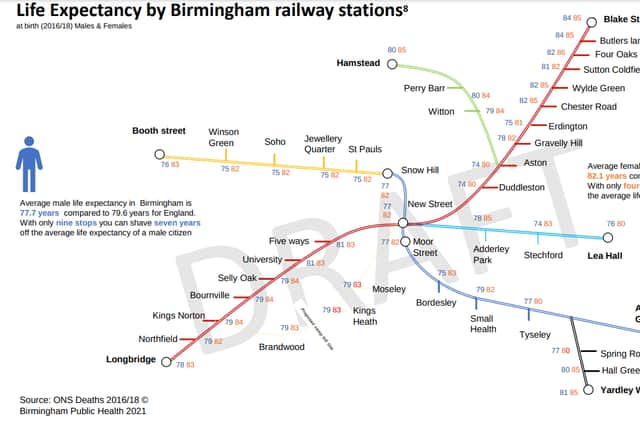Life expectancy: Men living in Sutton Coldfield are living 10 years longer than those at Aston
This article contains affiliate links. We may earn a small commission on items purchased through this article, but that does not affect our editorial judgement.
and live on Freeview channel 276
Life expectancy for men and women has been measured by railway stations across the city - with a shocking 10 years shaved off between just nine stops.
The graph has been drawn up by Birmingham Public Health using ONS data. It is being used by Birmingham City Council which is drawing up plans to address health inequalities over the next eight years.
Advertisement
Hide AdAdvertisement
Hide AdIt shows that a male living near Blake Street station in Sutton Coldfield can expect to until the age of 84 - while a man living near Aston or Duddeston stations can expect to live until 74.
Meanwhile a female living near Blake Street is expected to live until 85 years-of- age, while life expectancy for a woman living near the train stops in Aston or Duddeston is 80 years-old.
The life expectancy for both men and women is below the average for England.
On average a Birmingham make is currently expected to live for 77.7 years, while the average for England is 79.6 years.
Advertisement
Hide AdAdvertisement
Hide AdLife expectancy for Birmingham women is currently 82.1 years, while the average for England is 83.2 years.
You can see life expectancy across the city as per train station below:


What is Birmingham City Council’s strategy to combat the inequalities in health and wellbeing in Birmingham?
The council has drawn up a draft strategy and is seeking views from residents across the city. It has used information from the Covid-19 which highlighted huge disparities in quality of health across the city within different communities.
The draft strategy has four themes. These are:
- Creating a Healthy Food City
- Creating an Active City
- Creating a Mentally Healthy City
- Creating a City Without Inequality
The council says it has worked in partnership with several external agencies to create the draft strategy. These agencies are:
Advertisement
Hide AdAdvertisement
Hide Ad- Birmingham and Lewisham African and Caribbean Health Inequalities Review
- Seldom Heard Voices projects on physical activity and food,
- The Birmingham Food Conversation,
- The Covid Impact Survey,
- The use of ethnographic research in the Annual Director of Public Health Report and
- The re-commissioning of the Birmingham Poverty Truth Commission.
The council papers state: “The Covid-19 pandemic shone a harsh and relentless light onto inequalities as the pandemic disproportionately impacted on our most challenged and disadvantaged communities.
“The learning from the last twelve months of responding to the pandemic has informed the development of the strategy and been strengthened through the reinforcing of community conversations and engagement.”


Why are there health inequalities in Birmingham?
The city council has pointed out that there are several different issues that can affect life expectancy across the city.
These include access to green space, better quality housing and more comprehensive healthcare.
Advertisement
Hide AdAdvertisement
Hide AdPoverty and language barriers can also have a detrimental affect on longevity.
Is life expectancy the only health inequality across the city?
No, the report shows a range of data showing how different areas are impacted by different health issues.
In Nechells the rate of death from coronary heart disease is just over 2.5 times higher than the rate in Sutton Roughley.
• The incidence of breast cancer in Rubery and Rednal is 2.8 times that of Lozells.
Advertisement
Hide AdAdvertisement
Hide Ad• Rates of childhood excess weight in reception class are 1.7 times higher in Kings Norton South than in Sutton Trinity, and in Year 6 the rates in Handsworth are 2.2 times higher than Sutton Trinity.
• Hospital stays for self harm in Druids Heath and Monyhull are 4 times the rates in Sutton Wylde Green.
You can see the full Draft Health and Wellbeing Strategy Report here


How can I provide input to the health strategy currently being draw up by Birmingham City Council?
The Birmingham Health and Wellbeing Board would like your views on the proposed Birmingham Health and Wellbeing Strategy: Creating a Bolder, Healthier City.
Advertisement
Hide AdAdvertisement
Hide AdCreating a Bolder, Healthier City aims to address some of the critical challenges Birmingham faces, including tackling health inequalities and mitigating the legacy of the COVID-19 pandemic.
Your feedback on Creating a Bolder, Healthier City will help support the co-development of the strategy and facilitate action across the system to improve the health and wellbeing of our citizens and tackle health inequalities.
The information you provide will be kept confidential and used only for the purposes of this consultation.
A message from the editor:
Thank you for reading. BirminghamWorld is Birmingham’s latest news website, championing everything that is great about our city - reporting on news, lifestyle and sport. Find out more about who’s who in the team, and our editorial values. We want to start a community among our readers, so please follow us on Facebook,Twitter and Instagram, and keep the conversation going.
Comment Guidelines
National World encourages reader discussion on our stories. User feedback, insights and back-and-forth exchanges add a rich layer of context to reporting. Please review our Community Guidelines before commenting.
